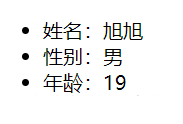React组件属性
蜡笔雏田学代码 人气:01.1基本理解和使用
1.1.1 使用React开发者工具调试
React Developer Tools
1.1.2 定义组件的方式
Ⅰ.函数式组件:
<script type="text/babel">
// 1.创建函数式组件 (首字母必须大写)
function MyComponent() { //(函数必须有返回值)
console.log(this) //undefined (本来this指向的是window,但是由于babel翻译完之后启用es5的严格模式,自定义的函数里的this不让指向window)
return <h2>我是用函数定义的组件(适用于【简单组件】的定义)</h2>
}
// 2.渲染组件到页面 (必须写组件标签)
ReactDOM.render(<MyComponent />, document.getElementById('test'))
</script>执行了ReactDOM.render(…之后发生了什么?
1.React解析组件标签,找到了MyComponent组件。
2.发现组件是使用函数定义的,随后调用该函数,将返回的虚拟DOM转为真实DOM,随后呈现在页面中。
类的基本知识复习移步到vscode
Ⅱ.类式组件:
复杂组件:如果组件是有状态的,那么就是复杂组件。
<script type="text/babel">
// 1.创建类式组件
class MyComponent extends React.Component {
render() {
// render是放在哪里的?——MyComponent的原型对象上,供实例使用
// render中的this是谁?——MyComponent的实例对象 <=> MyComponent组件实例对象
console.log('render中的this是谁:', this)
return <h2>我是用类定义的组件(适用于【复杂组件】的定义)</h2>
}
}
// 渲染组件到页面
ReactDOM.render(<MyComponent />, document.getElementById('test'))执行了ReactDOM.render(…之后发生了什么?
1.React解析组件标签,找到了MyComponent组件。
2.发现组件是使用类定义的,随后new出来该类的实例,并通过该实例调用到原型上的render方法。
3.将render返回的虚拟DOM转为真实DOM,随后呈现在页面中。
1.1.3 注意
- 组件名必须首字母大写
- 虚拟DOM元素
只能有一个根标签 - 虚拟DOM元素必须有
结束标签
1.1.4 渲染类组件标签的基本流程
- React内部会创建组件实例对象
- 调用render()返回得到虚拟DOM, 并解析为真实DOM
- 插入到指定的页面元素内部
1.2 组件实例的三大核心属性之一:state
1.2.1 理解
- state是组件对象最重要的属性, 值是
对象(可以包含多个key-value的组合) - 组件被称为"状态机", 通过
更新组件的state,来更新对应的页面显示(重新渲染组件) - 数据存放在状态里,来驱动对应页面的显示
1.2.2 案例
需求: 定义一个展示天气信息的组件
- 默认展示天气炎热 或 凉爽点
- 击文字切换天气
效果如下:

1.2.3 在类式组件使用state
<script type="text/babel">
// 1.创建组件
class Weather extends React.Component {
// 借助构造器初始化状态
// 构造器调用了几次?————1次
constructor(props) {
console.log('constructor')
super(props)
// 初始化状态
this.state = { isHot: true, wind: '微风' }
//解决changeWeather中this指向的问题
this.changeWeather = this.changeWeather.bind(this)
// 这是一个赋值语句,右边的this.changeWeather是指顺着原型链找到了changeWeather(),然后调用bind(),bind可以生成一个新的函数,改变this指向。括号中为传入的this,指得就是类中的实例对象
// 拿到了原型上的changeWeather,通过bind生成了一个新的changeWeather挂在实例自身
}
// render调用了几次?————1+n次 1是初始化的那次,n是状态更新的次数
render() {
console.log('render')
// 读取状态
const { isHot, wind } = this.state
// react:将changeWeather调用的返回值赋值给onClick,不用加括号
// 原生js:onclick时调用changeWeather函数,要加括号
return <h1 onClick={this.changeWeather}>今天天气很{isHot ? '炎热' : '凉爽'},{wind}</h1>
// 含义是:这是一个赋值语句,把右边这个函数交给onClick作为回调,
// 等你点击的时候,react帮你调changeWeather()函数
}
// changeWeather调用了几次?————点几次调几次
changeWeather() {
console.log('changeWeather')
// changeWeather放在哪里?——Weather的原型对象上,供实例使用
// 通过Weather实例调用changeWeather时,changeWeather中的this就是Weather实例
console.log(this) //undefined
// 因为changeWeather不是通过实例调用的,是直接调用,所以this不会指向 实例对象
// 那么 changeWeather 的this 是指向 undefined还是 window呢
// 是 undefined 因为 类中的局部函数默认开启了严格模式(类自动开的,与babel无关),所以不能指向 window
// 获取原来的isHot值
const isHot = this.state.isHot
// 严重注意:状态(state)里的数据不能直接进行更改,下面这行就是直接更改,react不认可!!!
// this.state.isHot = !isHot 错误写法
// 严重注意:状态必须通过setState进行修改,并且修改是一种合并,不是替换,只修改了isHot,wind不会丢失
this.setState({ isHot: !isHot })
}
}
// 2.渲染组件到页面
ReactDOM.render(<Weather />, document.getElementById('test'))
</script>1.2.4 在类式组件使用state的简写方式
<script type="text/babel">
// 1.创建组件
class Weather extends React.Component {
// 初始化状态时直接在类里面写赋值语句
state = { isHot: true, wind: '微风' }
render() {
const { isHot, wind } = this.state
return <h1 onClick={this.changeWeather}>今天天气很{isHot ? '炎热' : '凉爽'},{wind}</h1>
}
// 自定义方法 ————在用类去创建一个组件时,组件里所有自定义的方法都要用 赋值语句+箭头函数 的形式
changeWeather = () => { //箭头函数没有this,箭头函数内的this指向其外侧
const isHot = this.state.isHot
this.setState({ isHot: !isHot })
console.log(this)
}
}
ReactDOM.render(<Weather />, document.getElementById('test'))
</script>1.2.3 强烈注意
- 组件中
render方法中的this为组件实例对象 - 组件
自定义的方法中this为undefined,如何解决?
①强制绑定this:通过函数对象的
bind()
②箭头函数()=>{}
状态数据,不能直接修改或更新,状态必须通过setState进行修改
1.3 组件实例的三大核心属性之一:props
1.3.1 理解
- 每个组件对象都会有props(properties 的简写)属性
组件标签的所有属性都保存在props中 1.3.2 案例
需求: 自定义用来显示一个人员信息的组件
- 姓名必须指定,且为字符串类型
- 性别为字符串类型,如果性别没有指定,默认为男
- 年龄为字符串类型,且为数字类型,默认值为18
效果如下:

1.3.3 作用
- 通过
标签属性从组件外向组件内传递变化的数据 - 注意:
组件内部不要修改props数据,因为props是只读的
1.3.4 在类式组件使用props
先从内部读取某个属性值:
//实例对象身上有个属性props,需要传值进去,那怎么传呢?html标签能写标签属性(key:value),那么组件标签(<Person/>)也能写属性
// 解构赋值 提前从props身上拿到这三个属性
const { name, age, sex } = this.props对props中的属性值进行类型限制和必要性限制:
第一种方式(React v15.5 开始已弃用):
Person.propTypes = {
name: React.PropTypes.string.isRequired,
age: React.PropTypes.number
}第二种方式(新):使用prop-types库进限制(需要引入prop-types库)
//给Person加上propTypes属性,react就能帮你限制了
//写在Person类外面
Person.propTypes = {
// 具体的propTypes规则,要去PropTypes(React里面内置的一个属性)里面找
name: PropTypes.string.isRequired, //限制name必传,且为字符串
age: PropTypes.number //限制age为数值
}在类式组件使用props的简写方式
// 用static表示给类自身加上一个propTypes和defaultProps属性,而不是给类的实例对象加属性
// 写在Person类里面
static propTypes = {
name: PropTypes.string.isRequired, //限制name必传,且为字符串
sex: PropTypes.string, //限制sex为字符串
age: PropTypes.number, //限制age为数值
}
static defaultProps = {
sex: '男', //sex默认值为不男不女
age: 18 //age默认值为18
}扩展属性: 将对象的所有属性通过props传递
// 展开运算符在对对象使用时,应当注意以{}包裹起来
<Person {...person}/>
//...展开运算符具体运用看vscode默认属性值:
Person.defaultProps = {
age: 18, //age默认值为18
sex:'男'//sex默认值为男
}组件类的构造函数:
//开发中很少写构造器,能省则省
// 构造器是否接收props,是否传递给super,取决于:是否希望在构造器中通过this访问props
constructor(props){
// 只要写了构造器,就一定要调用super(),一定要传props
super(props)
console.log(props)//打印所有属性
}1.3.5 在函数式组件使用props
<script type="text/babel">
// 创建组件
//函数式组件能接收参数
function Person(props) {
// console.log(props)
const { name, sex, age } = props
return (
<ul>
<li>姓名:{name}</li>
<li>性别:{sex}</li>
<li>年龄:{age}</li>
</ul>
)
}
Person.propTypes = {
name: PropTypes.string.isRequired, //限制name必传,且为字符串
sex: PropTypes.string, //限制sex为字符串
age: PropTypes.number, //限制age为数值
}
Person.defaultProps = {
sex: '男', //sex默认值为不男不女
age: 18 //age默认值为18
}
ReactDOM.render(<Person name='旭旭' />, document.getElementById('test'))
</script>1.4 组件实例的三大核心属性之一:refs与事件处理
1.4.1 理解
组件内的标签可以定义ref属性来标识自己(相当于原生里是id)
1.4.2 效果
需求: 自定义组件, 功能说明如下:
- 点击按钮, 提示第一个输入框中的值
- 当第2个输入框失去焦点时, 提示这个输入框中的值
1.4.3 字符串形式的ref
<script type="text/babel">
// 创建组件
class Demo extends React.Component {
// 展示左侧输入框的数据
showData = () => {
const { input1 } = this.refs
alert(input1.value)
}
// 展示右侧输入框的数据
showData2 = () => {
const { input2 } = this.refs
alert(input2.value)
}
render() {
return (
<div>
<input ref="input1" type="text" placeholder="点击按钮提示数据" />
<button onClick={this.showData}>点我提示左侧的数据</button>
<input ref="input2" onBlur={this.showData2} type="text" placeholder="失去焦点提示数据" />
</div>
)
}
}
//渲染组件
ReactDOM.render(<Demo />, document.getElementById('test'))
</script>过时的API:String 类型的 Refs
如果你之前使用过 React,你可能了解过之前的 API 中的 string 类型的 ref 属性,例如
"textInput"。你可以通过this.refs.textInput来访问 DOM 节点。我们不建议使用它,因为 string 类型的 refs 存在 一些问题。它已过时并可能会在未来的版本被移除。
效果如下:

1.4.4 回调形式的ref
<script type="text/babel">
// 创建组件
class Demo extends React.Component {
// 展示左侧输入框的数据
showData = () => {
const { input1 } = this
alert(input1.value)
}
// 展示右侧输入框的数据
showData2 = () => {
const { input2 } = this
alert(input2.value)
}
// 回调函数的特点:你定义的,别人调的,最终执行了
// 回调函数的参数正是ref当前所处的那个input节点
render() {
return (
<div>
{/* 代码执行步骤: */}
{/* React加载Demo组件时,执行render函数内的jsx代码,发现input中有ref属性,属性内容是一个箭头函数,React就会帮我们调用这个回调函数,并且把当前的DOM传进这个函数,这样就可以接收到当前的DOM节点了,并把这个DOM放在组件实例自身上 */}
{/* 箭头函数接收到参数(当前的DOM节点)命名为(currentNode),将currentNode赋值给实例对象下的input1这个属性 */}
{/* 箭头函数只有一个参数可以省略'()',箭头函数右边只有一条函数体可以省略'{}' */}
{/*<input ref={currentNode => this.input1 = currentNode} type="<text>" placeholder="点击按钮提示数据" /> */}
<input ref={(currentNode) => { this.input1 = currentNode }} type="text" placeholder="点击按钮提示数据" />
<button onClick={this.showData}>点我提示左侧的数据</button>
<input ref={(currentNode) => { this.input2 = currentNode }} onBlur={this.showData2} type="text" placeholder="失去焦点提示数据" />
</div>
)
}
}
//渲染组件
ReactDOM.render(<Demo />, document.getElementById('test'))
</script>
效果如下:

1.4.5 回调ref中回调执行次数的问题(class的绑定函数)
<script type="text/babel">
// 创建组件
class Demo extends React.Component {
state = { isHot: true }
showInfo = () => {
const { input1 } = this
alert(input1.value)
}
changeWeather = () => {
// 获取原来的状态
const { isHot } = this.state
// 更新状态
this.setState({ isHot: !isHot })
}
savaInput = (currentNode) => {
this.input1 = currentNode;
}
render() {
const { isHot } = this.state
return (
<div>
<h1>今天天气很{isHot ? '炎热' : '凉爽'}</h1>
{/* React在更新组件时,会先传入null调用一次ref中的回调,以清空之前的ref;然后再传入参数currentNode,以调用第二次。每更新一次组件,ref中的回调函数就会被调用两次,一次传入null,一次传入参数currentNode。为了应对这种情况的出现,官方建议将ref的回调函数定义成 class 的绑定函数 的方式去避免上述的问题。 */}
{/*内联函数*/}
{/*<input ref={(currentNode) => { this.input1 = currentNode; console.log('@', currentNode) }} type="text" /><br /><br />*/}
<input ref={this.savaInput} type="text" /><br /><br />
<button onClick={this.showInfo}>点我提示输入的数据</button>
<button onClick={this.changeWeather}>点我切换天气</button>
</div>
)
}
}
//渲染组件
ReactDOM.render(<Demo />, document.getElementById('test'))
</script>
React在更新组件时,会先传入null调用一次ref中的回调,以清空之前的ref;然后再传入参数currentNode,以调用第二次。每更新一次组件,ref中的回调函数就会被调用两次,一次传入null,一次传入参数currentNode。为了应对这种情况的出现,官方建议将ref的回调函数定义成
class 的绑定函数的方式去避免上述的问题。
效果如下:

1.4.6 createRef创建ref容器
<script type="text/babel">
// 创建组件
class Demo extends React.Component {
myRef = React.createRef()
myRef2 = React.createRef()
/* React.createRef调用后可以返回一个容器,该容器可以存储被ref所标识的节点,该容器是“专人专用”的,也就是,调用React.createRef()创建了一个容器,通过赋值语句赋值给实例自身名为myRef的属性上 */
// 展示左侧输入框的数据
showData = () => {
// console.log(this.myRef)
alert(this.myRef.current.value)
}
// 展示右侧输入框的数据
showData2 = () => {
alert(this.myRef2.current.value)
}
// 回调函数的特点:你定义的,别人调的,最终执行了
// 回调函数的参数正是ref当前所处的那个input节点
render() {
return (
<div>
{/* React执行render函数中的jsx代码时,
发现input上有一个ref属性而且是通过createRef方法创建的,
React就会把当前ref属性所在的DOM节点放到之前创建的那个容器上,
也就是把当前input这个DOM节点放到了实例自身名为myRef的容器上 */}
{/* 可以简写成ref={this.myRef = React.createRef()} */}
<input ref={this.myRef} type="text" placeholder="点击按钮提示数据" />
<button onClick={this.showData}>点我提示左侧的数据</button>
{/* 发生事件的元素正好是需要操作的元素本身,可以省略ref */}
<input ref={this.myRef2} onBlur={this.showData2} type="text" placeholder="失去焦点提示数据" />
</div>
)
}
}
//渲染组件
ReactDOM.render(<Demo />, document.getElementById('test'))
</script>效果如下:

1.4.7 事件处理
- 通过
onXxx属性指定事件处理函数(注意大小写) - React使用的是自定义(合成)事件, 而不是使用的原生DOM事件-------为了更好的兼容性
- React中的事件是通过事件委托方式处理的(委托给组件最外层的元素)--------为了高效
通过event.target得到发生事件的DOM元素对象------不要过度使用ref
<script type="text/babel">
// 创建一个组件
class Demo extends React.Component {
showInfo = () => {
alert(this.myRef.current.value)
}
showData = (event) => {
// 传入的event是发生onBlur事件的事件源,也就是失去焦点提示数据的input框,
// 通过event.target.value拿到input中的值
alert(event.target.value)
}
render() {
return (
<div>
<input ref={this.myRef = React.createRef()} type="text" placeholder="点击按钮提示数据" />
<button onClick={this.showInfo}>点我提示左侧数据</button>
<input onBlur={this.showData} type="text" placeholder="失去焦点提示数据" />
</div>
)
}
}
// 渲染组件到页面
ReactDOM.render(<Demo />, document.getElementById('test'))
</script>1.5 收集表单数据
1.5.1 理解
包含表单的组件分类
- 受控组件
- 非受控组件
1.5.2 案例
需求: 定义一个包含表单的组件
输入用户名密码后, 点击登录提示输入信息
效果如下:

Ⅰ.非受控组件
对input(以及页面中其他的一些输入型DOM)中输入的数据
现用现取,就是非受控组件
<script type="text/babel">
// 创建一个组件
class Login extends React.Component {
// handleSubmit函数中直接取出input中输入的数据(现用现取)
handleSubmit = (event) => {
event.preventDefault() //阻止表单提交
const { username, password } = this
alert(`你输入的用户名是: ${username.value}, 你输入的密码是: ${password.value}`)
}
render() {
return (
// 对input(以及其他的一些输入型DOM)中输入的数据现用现取,就是非受控组件
<form onSubmit={this.handleSubmit}>
用户名:<input ref={(c) => { this.username = c }} type="text" name="username" />
密码:<input ref={(c) => { this.password = c }} type="password" name="password" />
{/* form中的button默认提交,点击后触发表单提交事件onSubmit */}
<button>登录</button>
</form>
)
}
}
// 渲染组件到页面
ReactDOM.render(<Login />, document.getElementById('test'))
</script>Ⅱ.受控组件
页面中所有输入类的DOM(input框),随着用户的输入,能把输入的东西维护到状态里(
state),等需要用时,直接从状态里面取出来,就是受控组件。(类似于vue里的双向绑定)
<script type="text/babel">
// 创建一个组件
class Login extends React.Component {
// 初始化状态
state = { username: '', password: '' }
// 保存用户名到状态中
saveUsername = (event) => {
this.setState({ username: event.target.value })
}
// 保存密码到状态中
savePassword = (event) => {
this.setState({ password: event.target.value })
}
// 表单提交的回调
handleSubmit = (event) => {
event.preventDefault() //阻止表单提交
const { username, password } = this.state
alert(`你输入的用户名是: ${username}, 你输入的密码是: ${password}`)
}
/*
受控组件:(能够省略ref)
页面中所有输入类的DOM(input框),随着用户的输入,能把输入的东西维护到状态里(state),等需要用时,直接从状态里面取出来
数据被onChange函数监听,只要输入型DOM数据一改变就触发onChange中指定的回调函数
回调函数saveUsername和savePassword中对改变的数据进行保存,保存到state中,需要使用的时候才取出。
*/
render() {
return (
<form onSubmit={this.handleSubmit}>
用户名:<input onChange={this.saveUsername} type="text" name="username" />
密码:<input onChange={this.savePassword} type="password" name="password" />
<button>登录</button>
</form>
)
}
}
// 渲染组件到页面
ReactDOM.render(<Login />, document.getElementById('test'))
</script>加载全部内容